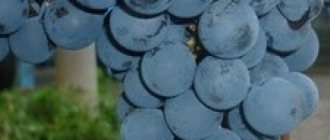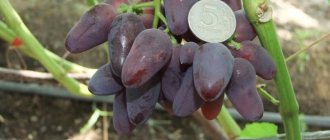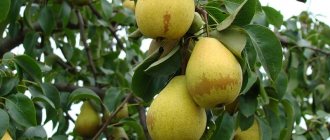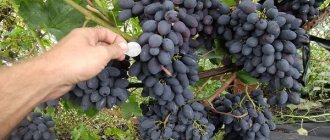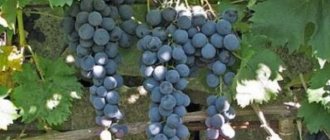Origin
The lion's share of all grape varieties owes their “birth” to the hands of amateur breeders who do not have special education or experience in the relevant industries. The “monarch” variety, which was bred by Evgeniy Georgievich Pavlovsky, a miner from Novoshakhtinsk, Rostov region, is no exception, as well as 50 other hybrid forms.
The parents of the “monarch” are “mascot” and “cardinal”
The development of the new variety was a two-stage process:
- The red variety “Cardinal”, bred by American breeders, was pollinated with a mixture of pollen from European-Amur grape forms.
- The result of the crossing was treated with pollen from the Russian white grape variety “Talisman” (“Kesha”).
The result of such an experiment, carried out back in 1988, exceeded all expectations: the variety turned out to be resistant to low temperatures and fungal diseases, visually attractive and with a pleasant sweet and sour taste. Initially, the new grape was named “monarch”, but due to the fact that the “black monarch” variety already existed in the German breeding collection, Pavlovsky subsequently changed the name to “peridot”. Under this name, the white Pavlovsky grape was registered in the Russian State Register of Breeding Achievements, although “among the people” its fame was consolidated under its original name.
History of selection
According to the originator, the variety is the result of a combinative selection carried out by E. G. Pavlovsky in collaboration with specialists from the All-Russian Research Institute of Viticulture and Winemaking named after. Ya. I. Potapenko.” Some sources indicate that during breeding, “Talisman” and “Cardinal” + pollen mixture were used for crossing.
Grape varieties that served as parent forms: "Talisman" (left) and "Cardinal" (right)
At the end of the 90s of the last century, this hybrid form did not leave professional winegrowers indifferent and was actively tested both in farmer-amateur plantings and in experimental production farms in the Anapo-Taman, Foothill and Central zones of Kuban, as well as in the Don and Ukraine .
In 2013, “Monarch” was submitted for testing in the GSK RF system, under the name “Chrysolite”, and in 2015 it was officially registered in the State Register of Breeding Achievements as intended for private production of table grapes in all regions of Russia. “Chrysolite” is protected by a copyright certificate and a patent. Today, it is included in the list of 12 promising table varieties for Eurasia; it is successfully cultivated not only in Russia, but also in Ukraine, Belarus and other post-Soviet countries.
You can get acquainted with the features of “Monarch” in more detail from the video filmed by a Ukrainian amateur winegrower:
Main characteristics
“Monarch” is considered one of the best white grape varieties due to its early ripening, massive clusters and soft, pleasant taste. White varieties such as “Delight” and “Anthony the Great” also deserve attention.
Ripening period
“Monarch” is an early-medium ripening hybrid. This means that from the moment the buds swell until the berries fully ripen, about 130 days usually pass. Harvest time depends on the growing region: in the south, the fruits ripen by mid-August, in the central zone - by mid-September.
Bush
“Monarch” is “majestic” in everything. Its bush is vigorous and can stretch up to 2.5 - 5 meters. The average length of its vegetative shoots is 120 – 135 cm.
The dark green leaves are medium-sized, five-lobed and heart-shaped.
The flowers are bisexual, white or pale green.
Bunches and berries
The “monarch” clusters look massive, although their weight ranges from 0.5 to 1 kg. The shape of the brush is conical or cylindrical-conical, the density of berries on it is average.
The oval berries taper slightly towards the bottom. Their average size is 32 by 26 mm, and their weight is 15 - 19 g. The skin is loose, and when chewed it is practically not felt. It is painted amber-yellow, and on the side that is more exposed to sunlight, there are reddish inclusions. The pulp is dense, juicy, contains only 1 – 2 seeds. The sugar content in fruits is 16–18%, and the acid content is 4–5 g/l.
Taste
Monarch berries have a pleasant dessert taste with hints and aroma of nutmeg.
Productivity
“Monarch” gives a relatively good, and, most importantly, stable harvest - from 10 to 13 kg per bush.
Description of the plant and specifics of cultivation
The vine is distinguished by very high growth vigor and good ripening of shoots, sometimes by 2/3 of the length. The perennial parts of the bush are covered with reddish, coarse-fibrous bark. Fruitful shoots range from 60 to 75%, on average the load on each is 1.1-1.3 bunches. Shoots that are too thin and grow from the head of the bush are not left for fruiting. To obtain a stable and high-quality harvest, experts recommend medium pruning (by 6-8 buds) of fruit shoots.
“Monarch” can produce a second full-fledged crop on its stepsons, ripening 2-3 weeks later than the main one. Experienced winegrowers recommend long pruning (10-12 buds) and, if the bush is underloaded with the main crop, early pinching in order to obtain a stepchild.
For full fruiting, “Monarch” does not require joint planting with other pollinating varieties
The leaves are large, dark green, five- or three-lobed (rare), slightly dissected. The petiole is open, lyre-shaped with a rounded bottom and a neatly cut jagged edge. The flowers are slightly greenish, small (3-5 mm in diameter), bisexual. During the flowering period and after it, the plant shows a tendency to shed flowers and ovaries, which, as a rule, leads to the formation of excessively loose (defective) bunches and, as a consequence, to a shortage of harvest and a deterioration in its marketable qualities.
The opinion of an amateur winegrower about agricultural techniques that reduce the shedding of flowers and ovaries can be found in the following video:
Comparison with analogues
The “monarch” variety looks decent in comparison with other varieties of white mid-early grapes. Comparative characteristics are presented in the table.
| Sign | Variety | |||
| Monarch | Alexa | Lily of the valley | Mascot | |
| Ripening period | 125 – 135 days | 120 – 130 days | 120 – 130 days | 120 – 135 days |
| Frost resistance | -25C | -25C | -21C | -25C |
| Productivity | 10-13 kg | Up to 40 kg | 10 – 20 kg | 5 – 7 kg |
| Bunches | 0.5 – 1 kg | 800 g – 1 kg | Up to 1 kg | 800 g – 1.5 kg |
| Taste | Shades of nutmeg | Taste of nutmeg | Muscat notes | Muscat |
| Color | Amber yellow | Light green | Yellow-green | Amber |
| Disease resistance | Above average | Below average | Above average | Above average |
| Shelf life | 2 – 3 months | 2 – 3 months | Up to 3 months | Up to 6 months |
| Sugar accumulation | 16 – 18% | 20% | 16% | 17 – 23% |
| Acidity | 4 – 5 g/l | 6 g/l | 5 – 7 g/l | 6 – 8 g/l |
Monarch grapes: characteristics, pros and cons of the variety
Photo of Monarch grape variety
This variety is valued for its juicy, sweet taste with a muscat tint, beautiful clusters and excellent presentation. The advantages include the following characteristics :
- early variety, ripens by the end of August
- high yield, up to 20 kg per bush
- on the bunches all the fruits are the same size and the same ripeness, there are no small, unripe ones
- high frost resistance of the bush, can withstand up to -250
- resistant to pests and diseases, the bush tolerates weather changes well
- dense skin that is not damaged during transportation
- good taste
- excellent presentation
- cuttings take root well, root easily
Unfortunately, not a single plant is without its drawbacks, here are some drawbacks :
- shedding of the ovaries, therefore it is very important to thin out the bunches in time; you cannot thin out during flowering, this procedure should be postponed to the period when the berries are forming; untimely feeding also leads to shedding of ovaries
- not resistant to powdery mildew, this disease can lead to a lack of harvest, so preventive measures must be taken immediately.
Features of cultivation
“Monarch” is a highly resistant variety created for cultivation throughout Russia and the countries of the former CIS.
Boarding time
Experienced winegrowers recommend planting “monarch” seedlings in the spring, provided the air warms up to +15ºС and above, the soil warms up to +10ºС and above, and there is no threat of return frosts. But grafting onto a rootstock can be done not only in spring, but also in autumn.
Place and soil
“Monarch” loves light, so you will have to allocate it the most illuminated place in the garden. It would be good if this area was also protected from drafts and erosion by groundwater. It is ideal if the walls of houses and structures located on the south side are chosen as support: they will protect from gusts of cold wind and will subsequently help give the desired direction for the growth of a powerful bush.
The main condition for the soil is looseness and moderate moisture. If the soil on the site does not meet the requirements, then it is advisable to enrich it with peat, humus, and compost. The ideal soil for grapes is discussed in a separate article.
The technology for planting seedlings is no different from the usual one. Recommended dimensions for the planting hole are 90 cm in diameter and 80 cm in depth; between neighboring bushes - at least 1 m.
Watering and fertilizing
“Monarch” does not tolerate excess moisture, so watering measures must be carried out strictly according to the schedule: twice before flowering, during the formation of the ovary and subsequently as needed (determined by the top layer of soil). Typically, it is recommended to pour 20–30 liters of water under a bush during one watering.
Feeding the plant will have a positive effect on the future harvest. After a long winter, it should be topped up (added with water) with organic or nitrogen-containing fertilizers, and at the time of flower formation - with potassium and phosphorus.
Important! A 3 cm thick mulch of rotted manure will help retain moisture and saturate the roots with useful elements.
Trimming
The recommended load on the bush is no more than 40 eyes. Pruning is performed when the grapes are at rest: 4 to 6 eyes are left at each level. Do not forget about removing damaged and frozen shoots after winter, and during fruit set - extra trusses. In summer, you will have to remove those leaves that cover the brushes from sunlight.
Wintering
The frost-resistant variety needs insulation only if in winter the thermometer drops below -25ºС. This means that in the southern regions (Crimea, Krasnodar Territory) the plant does not need to be covered, but in the regions of the Middle Zone (including the Moscow region), the winegrower will have to work hard.
After autumn pruning, the vines are removed from the trellis, tied together and laid on the ground. They can be covered on top with agrofibre, hay, humus, or they can also be buried with ordinary soil.
Diseases and pests
The undoubted advantage of the “monarch” is its high resistance to mildew and gray rot. But the variety demonstrates average resistance to oidium, so no one is immune from the possibility of developing unpleasant symptoms. The only correct solution is preventive treatment of bushes with Bordeaux mixture, Chorus and Ridomil, etc.
Insecticides “Aktellik”, “Zolon”, “Confidor” and others will help cope with phylloxera. But with birds, the most effective method of control is mechanical, which involves isolating grape bunches with fine mesh nets. Increasingly, special sound repellers (Korshun-8 and VK-20) began to appear on the market, which are also very effective in this fight.
Harvest storage
The advantage of the variety is its excellent transportability: the berries remain on the bunch, do not fall off, while maintaining an excellent presentation.
The harvest takes place at the end of summer. Ripe bunches are cut with pruning shears and carefully placed in one layer in wooden boxes. Those brushes that are planned to be consumed fresh a little later can be left directly on the bushes: the fruits of this variety may not fall off for a long time. The best storage option is a refrigerator or basement. Some winegrowers stretch twine in the basement, on which they hang the grapes.
Important! Potatoes that are attached to the cuttings of the branches will help to extend the shelf life of the fruits: it will nourish them.
Cultivation regions
The variety is recommended for cultivation throughout almost the entire territory of Russia: from the south to regions with climatic conditions that are not always suitable for agricultural work (Ural, Siberia).
Monarch grapes: description of correct planting of cuttings
Monarch grapes: description of correct planting of cuttings
If you have not been growing grapes for several years, then it is better to start by buying a ready-made seedling from a trusted nursery. You need to immediately look at the cut so that it is green, fresh, and there are three buds. The root system should be developed, strong, with white lateral shoots.
Before planting in the ground, the cuttings are soaked in water or planted in moist soil, and left in this state until a stable root system develops and the first green leaves appear. To graft a cutting, you first need to carefully cut it off, then soak it in water for 14 hours at a water temperature of 150. Then, place the cutting in a solution of Humate, 10 drops per 1 liter of water. If you don’t have special solutions for a growth stimulator, you can use the old “old-fashioned” method - half a tablespoon of honey per 5 liters of water. Experienced agronomists, in order to preserve the cuttings, perform a waxing procedure. I carry out the procedure with caution, without damaging the young shoots. Simply dip the branch into melted paraffin, then immediately into cold water and transfer to dry.
Useful properties and applications
“Monarch” is a real storehouse of useful vitamins and minerals, which together have a positive effect on human health.
| Organ | Positive Impact |
| Gastrointestinal tract | Normalizes digestion. |
| Improves metabolism. | |
| Nervous system | Tones and invigorates. |
| Relieves the effects of stress. | |
| Improves emotional mood. | |
| Excretory system | Removes toxins and salts. |
| The cardiovascular system | Strengthens the walls of blood vessels. |
| Lowers cholesterol levels. | |
| It prevents strokes. | |
| Reduces blood pressure. | |
| Leather | Helps smooth out wrinkles. |
| Blood | Improves blood composition. |
| Increases hemoglobin levels. | |
| Prevents the development of anemia. |
Reference! 100 grams of product contains 65 kcal.
“Monarch” is a table grape variety that is recommended, first of all, to be consumed fresh. It can be used to produce muscat wine, jam, juice, and grape vinegar.
The taste of wine made from the “monarch” variety is distinguished by a delicate and refined taste - a fruit and berry bouquet with light woody notes in the aroma.
Seasonal care, pruning and fertilization
It is preferable to do pruning in the spring, before the growing season, to stimulate active growth of shoots. On bushes that are more than 5 years old, pruning is also done in the fall to rejuvenate the bush.
In summer, weeds are carefully removed and watered. In dry summers, water the plant at least once every 7 days. In the northern regions, Monarch grapes are wrapped in agrofibre for the winter. If winters in your region are harsh, it is recommended to choose varieties that are more cold-resistant.
In the spring, pruning is done and liquid nitrogen fertilizers are applied. For preventive purposes, twice a year, experienced summer residents are advised to treat grapes against pests with any preparations. You can buy them at any agricultural store or garden markets.
Photo
Next, check out the photos and reviews about the “monarch” variety.
Prevention of diseases and pests
The monarch is not susceptible to disease, with the exception of powdery mildew, which affects all parts of the bush. To prevent the disease, spray with 1% Bordeaux mixture strictly according to the manufacturer’s instructions.
The most dangerous pests are wasps, lovers of sweet berries. But they harm not only berries. After their invasion, bare branches may remain. Insecticides are useless here. To protect the crop, a light fabric bag is put on each brush. The work is labor-intensive, but productive.
Wasp protection
Reviews
The Monarch has a very large berry, amber in color, without peas, the flesh is dense, with a slight nutmeg. Ripens around August 20th. Vladimir, Salsk, Rostov region.
My Monarch has no trace of peas, cracking, or disease. And quite marketable bunches. Alexander, Kyiv region.
Decent shape, good stability, taste and interesting appearance of the berry with a pink tint when fully ripe. Maxim, Lugansk
Selecting a site for planting, taking into account the type of soil, watering
Loamy, clay or sandy soils are suitable for Monarch. Like any other grape, this fruit plant does not tolerate light deficiency.
In poor lighting conditions, the berries grow small and not sweet enough.
When planting Monarch grapes, you should choose an open area with support. The distance from the nearest building is at least 50 cm. A distance of 1.5 meters is maintained between young seedlings, so that a couple of years later in the fall it will be convenient to harvest from mature bushes.
How to trim grapes (video)
The originator of the form gave recommendations according to which the inflorescences of the Monarch grapes should not be normalized before the flowering stage. Experienced winegrowers do not advise cutting out unnecessary shoots in order to eliminate the risk of shedding of the ovaries. Rationing can be carried out after flowering, when the berries are at the stage of formation and do not exceed the size of a pea.
The hybrid form of the Monarch grape is quite capricious, which requires strict implementation of agricultural technology. It is for this reason that the variety is not always successful for novice gardeners.
